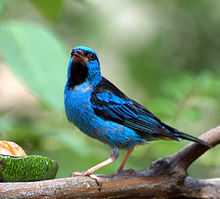Blue Dacnis
| Blue Dacnis | |
|---|---|
 | |
| Adult male | |
 | |
| Adult female in São Paulo, Brazil | |
| Conservation status | |
| Scientific classification | |
| Kingdom: | Animalia |
| Phylum: | Chordata |
| Class: | Aves |
| Order: | Passeriformes |
| Family: | Thraupidae |
| Genus: | Dacnis |
| Species: | D. cayana |
| Binomial name | |
| Dacnis cayana (Linnaeus, 1766) | |
| Synonyms | |
|
Dacnis coerebicolor | |
The Blue Dacnis or Turquoise Honeycreeper (Dacnis cayana) is a small passerine bird. This member of the tanager family is found from Nicaragua to Panama, on Trinidad, and in South America south to Bolivia and northern Argentina. It is widespread and often common, especially in parts of its South American range.
It occurs in forests and other woodlands, including gardens and parks. The bulky cup nest is built in a tree and the normal clutch is of two to three grey-blotched whitish eggs. The female incubates the eggs, but is fed by the male.[2]
The Blue Dacnis is 12.7 cm long and weighs 13 g. Despite its alternative name, it is not a honeycreeper, which are longer-billed. The adult male is turquoise blue with a black around the eyes, and on the throat and back. The wings and tail are black, edged with turquoise. The female and immature are mainly green with a blue head, paler green underparts and green-edged brown wings.
These are social birds which eat mainly insects gleaned from foliage, flowers or bromeliads. Fruit is often taken and usually swallowed whole, but nectar is rarely consumed. The Blue Dacnis’s call is a thin tsip.
The Purplish Honeycreeper (Chlorophanes purpurascens), a bird from Venezuela known only from the type specimen, is considered to be an intergeneric hybrid between the Green Honeycreeper and either the Red-legged Honeycreeper or the Blue Dacnis.[3]

References
- ↑ BirdLife International (2012). "Dacnis cayana". IUCN Red List of Threatened Species. Version 2013.2. International Union for Conservation of Nature. Retrieved 26 November 2013.
- ↑ Pereira, José Felipe M. (2008) Aves e Pássaros Comuns do Rio de Janeiro, Rio de Janeiro: Technical Books, p. 130, ISBN 978-85-61368-00-5
- ↑ Storer, Robert W. (1957). "The Hybrid Origin of Chlorophanes purpurascens". Auk 74 (4): 507. doi:10.2307/4081756.
Further reading
- ffrench, Richard (1991). A Guide to the Birds of Trinidad and Tobago (2nd ed.). Comstock Publishing. ISBN 0-8014-9792-2.
- Hilty, Steven L (2003). Birds of Venezuela. London: Christopher Helm. ISBN 0-7136-6418-5.
External links
| Wikimedia Commons has media related to Dacnis cayana. |
- Blue Dacnis videos on the Internet Bird Collection
- Blue Dacnis photo gallery VIREO
- Photo-High Res; Article geometer—"Birds of Brazil"
- Article, and Write-up:Male and Female Photos fireflyforest.net—"Blue Dacnis"
